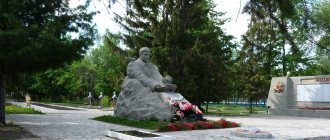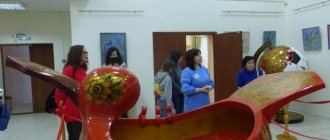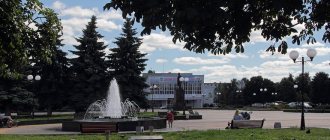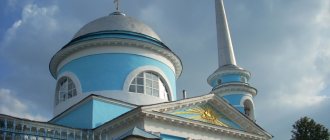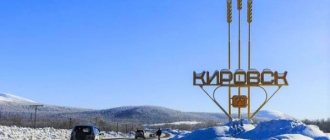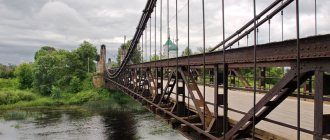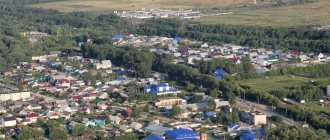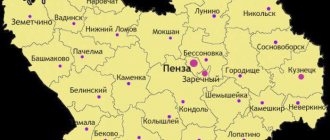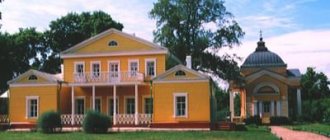Kamenka
(Penza region)
OKATO code:
56229501
Founded:
18th century.
Urban-type settlement since:
1944
City since:
1951 City of district subordination (Kamensky district, Penza region)
Center:
Kamensky district
Telephone code (reference phone)
| 84156***** | 22-2-22 |
Deviation from Moscow time, hours:
0
Geographic latitude:
53°11′
Geographic longitude:
44°03′
Altitude above sea level, meters:
180 Sunrise and sunset times in the city of Kamenka
Sights of the Kamensky district of the Penza region
Natural attractions
A watershed consisting of 28 rivers Poperechenskaya steppe “Kuvaka” spring Kholenevsky, Kevdinsky, Polyushkin, Forgiven and other consecrated springs
Archaeological sites
On the territory of the Kamensky district there are 52 mounds and the famous sites “Zimnitsa” and “Wolf Ravine”
Historical and architectural sights
Golovinshchinsky merchant - six Tatar-Mishar villages of the Penza region, which were settled by Akzhigitov Arslan Polkaev: Kikino, Kobylkino, Kuteevka, Mochaleika, Telyatino, Reshetino.
Vladykino “noble nest”
Museums
Museum of P.I. Zamoyskogo in the village. Sobolevka
Museum of Kikinsky Municipal Educational Institution Secondary School
Religious and ritual sites
Source
Map
| Kamenka: maps |
Kamenka: photo from space (Google Maps) Kamenka: photo from space (Microsoft Virtual Earth)
| Kamenka. Nearest cities. Distances in km. on the map (in brackets along roads) + direction. Using the hyperlink in the distance , you can get the route (information courtesy of the AutoTransInfo website) | |||
| 1 | Nizhny Lomov | 45 (150) | NW |
| 2 | Mokshan | 47 (85) | NE |
| 3 | Belinsky | 48 (51) | SW |
| 4 | Theology | 50 () | IN |
| 5 | Pachelma | 51 (111) | Z |
| 6 | Kolyshley | 62 (116) | SE |
| 7 | Penza | 64 (72) | IN |
| 8 | Bessonovka | 66 (90) | IN |
| 9 | Bashmakovo | 67 (91) | Z |
| 10 | Zasechnoe | 69 () | IN |
| 11 | Grabovo | 71 (99) | IN |
| 12 | Zarechny | 74 (78) | IN |
| 13 | Condol | 78 (100) | SE |
| 14 | Insar | 78 (214) | WITH |
| 15 | Suitcase | 80 (87) | IN |
| 16 | Serdobsk | 80 (89) | YU |
| 17 | Narovchat | 81 (185) | WITH |
| 18 | Prigorodnoye | 83 () | YU |
| 19 | Bekovo | 83 (166) | YU |
| 20 | Vadinsk | 86 () | NW |
| 21 | Tamala | 89 (104) | SW |
| 22 | Lunino | 89 (126) | NE |
| 23 | Issa | 92 (137) | NE |
| 24 | Gavrilovka 2nd (Tambov region) | 92 (155) | Z |
| 25 | Kovylkino | 94 (214) | WITH |
| 26 | Shemysheyka | 95 (123) | IN |
| 27 | Kadoshkino (Republic of Mordovia) | 97 (213) | WITH |
| 28 | Umet (Tambov region) | 99 (127) | SW |
| 29 | Malaya Serdoba | 100 () | SE |
| 30 | Zemetchino | 101 (129) | Z |
| 31 | Spassk | 101 (208) | NW |
a brief description of
The city is located on the western outskirts of the Volga Upland, on the river. Atmis (Oka basin), 75 km west of Penza. Railway station. Belinskaya.
Territory (sq. km): 24
Information about the city of Kamenka on the Russian Wikipedia site
Historical sketch
The village of Kamenka arose in the 18th century; The name is due to the rocky nature of the soil.
Workers' village of Kamenka since 1944. City since 1951.
Economy
Factories: machine-building, Belinskselmash, brick, Stroydetal, cereal, sugar, feed mills, butter, brewery, meat processing plant, etc.
Cattle are raised in the Kamensky district.
Deposits of brick loams. Mineral water "Kuvaka".
Main enterprises
MECHANICAL ENGINEERING
OJSC "Belinskselmash"
442206, Penza region, Kamensky district, Kamenka, st.
Chernyshevsky, 1 Offers:
seeders, potato planters, cultivators, oven, cast iron castings
FOOD FLAVORS INDUSTRY
JSC "ABelinskselmash" - multi-storey buildings. In the center of the new part is a park.
Former Voeikov Palace. Monuments to V.G. Belinsky, M.Yu. Lermontov.
| Population by year (thousands of inhabitants) | |||||||
| 1861 | 0.7 | 1996 | 46.7 | 2008 | 39.3 | 2017 | 36.6 |
| 1939 | 8.3 | 1998 | 46.5 | 2010 | 38.9 | 2018 | 35.9 |
| 1959 | 25.2 | 2000 | 44.5 | 2011 | 39.6 | 2019 | 35.2 |
| 1967 | 29 | 2001 | 44.0 | 2012 | 39.1 | 2020 | 34.6 |
| 1970 | 30.1 | 2003 | 40.7 | 2013 | 38.4 | 2021 | 33.9 |
| 1979 | 35.3 | 2005 | 40.4 | 2014 | 37.8 | ||
| 1989 | 40.1 | 2006 | 39.9 | 2015 | 37.5 | ||
| 1992 | 41.8 | 2007 | 39.5 | 2016 | 37.0 | ||
History of the city of Kamenka, Penza region
District center. 75 km west of the city of Penza, Belinskaya railway station on the Penza-Moscow line, Penza-Tambov highway. Located on both banks of the Atmis (the left tributary of the Moksha). As of January 1, 2006, the area is 2395 hectares, 39917 inhabitants.
The main industries are agricultural engineering, the food industry, and the building materials industry. As of January 1, 1995, the largest enterprises were: Belinskselmash JSC (over 3 thousand employees) - seeders, cultivators, potato planters, harrows, etc.; meat processing plant (773 people); sugar (779 people); brick factory (125 people); elevator (282 people); (395 people) – reinforced concrete and carpentry products. Creamery, bakery (confectionery, canned vegetables), brewery, cereal factory, etc. Railway station, bus station, passenger vehicle enterprise (25 buses, 7 city routes). – repair of cars of all brands; JSC Kamagroservice – maintenance of agricultural machinery and livestock farms. 3 mobile mechanical columns “Agropromspetsstroy”, 2 – “Penzvodmelioration”. Branch of the commercial bank "Tarkhany". On the balance sheet of the city's housing and communal services are 80,977 sq. m of housing, including 72,823 sq. m with all amenities (1989).
As of January 1, 1995, there were city (260 beds) and district (310 beds) hospitals, 2 health centers, 3 pharmacies. 9 secondary schools, incl. 8 secondary (6272 students); mechanical engineering college (286 students), vocational school No. 13 (trains specialists in mass professions for the village). 3 houses of culture, 6 libraries, music and art schools, a park of culture and recreation, a cinema, 2 stadiums, 2 children's and youth sports schools. 2 churches (Dmitrievskaya and Sergievskaya). Intracity television has been operating since January 1993. 4 monuments to soldiers who died during the Great Patriotic War - fellow countrymen and those who died in the local evacuation hospital. 11.5 thousand pensioners.
The historical center of the city is located on the right bank of the Atmis. The planning structure of the right bank part is curvilinear, oriented towards the shore line, the transverse streets stretch towards the river. In the second half of the 19th century, administrative buildings were built in the central part, which, together with shops and Voeikov’s estate, formed a well-defined trading area. The bridgehead square appeared thanks to the development of the right bank. Large construction began in connection with the evacuation to Kamenka and receiving the status of a workers' settlement on June 15, 1944, and the status of a city on April 18, 1951. The left bank part developed at a high rate, where the main housing construction was located in connection with the deployment on the left bank, where 2 thousand people worked at the end of the war. Its layout is distinguished by a rectilinear grid of streets with multi-apartment sectional buildings.
The administrative center remains in the old part of the city, here on the bridge square there is a memorial to fallen soldiers, and on Sovetskaya Street there is a system of public gardens, administrative buildings, a number of architectural monuments: the former Land Peasant Bank (1913), post office (1913), estate complex, with a palace , owner of local lands Voeikov (1914), on Pervomaiskaya Street - a hotel of the second half of the 19th century. In the 1990s, in the area of the railway station, a residential microdistrict was built with German funds for military personnel withdrawn from this country.
Kamenka was founded at the beginning of the 18th century in the area of an ancient stone ford across the Atmis River on the way from Penza to Nizhny Lomov and Tambov, and even earlier, apparently, from the Golden Horde city of Ukek (Uvek in Saratov) to the city of Mokhshi (Narovchat). The settlement was named after this ford. In 1710 - a village with 8 courtyards of Major General Ivan Mikhailovich Golovin. In 1717, the village of Dmitrievskoye (after the church in the name of St. Dmitry Selunsky), Kamenka, too, was devastated by the Kuban. At the end of the 18th century, it was an agricultural village with small oil mills based on hemp cultivation and potash factories; there were 4 water mills on Atmis. Thanks to the Penza-Tambov highway, peasants earned extra money by transporting merchant goods, engaged in small trade and providing services to travelers. Local residents participated in the Peasant War on the side of E.I. Pugachev (1774), and the peasant Ivan Ivanov gathered a small detachment here with which he tried to capture Penza. In 1795, all 165 peasant households in the village of Dmitrievskoye and Kamenka were on quitrent and paid 3 rubles per revision person per year. In the middle of the 19th century, on Frolov’s estate, Angora rabbits were bred here to obtain wool from them; A.P.’s distillery operated nearby. Bystrovoy. At the end of the 19th century, there were 503 Baptists and Old Believers of the Beglopopovian persuasion in the village. In 1918, a second-level school opened. From the time of its foundation until 1928, the settlement was part of the Nizhnelomovsky district, and since the 1860s it has been a volost center. In the 1870s, thanks to the efforts of the local landowner General Voeikov, the railway from Moscow to Penza passed through Kamenka, and the station was named Voeikovskaya. In 1878, a zemstvo school opened in the village. In the 1900s, while commandant of the Winter Palace in St. Petersburg, he announced his intention to build a resort in Kamenka and cure Tsarevich Alexei of hemophilia. It was for the prince that Voeikov's palace in this village was intended. At the same time, the owner of the palace did a lot to promote the healing properties of local water from springs in the Kuvaka ravine, launching a carbon dioxide production plant for this purpose. In 1913, there were about 30 small enterprises: steam mills, cereal mills, hemp milling, carbon dioxide, brick, etc. During the Russian Revolution of 1905–1907, it was one of the major centers of the agrarian movement in Nizhnelomovsky district. In October 1913, a monument to the “Tsar-Liberator” Alexander II was unveiled in the center of the village; the ceremony was attended by the commandant of the Winter Palace V.N. Voeikov and the Penza governor Lilienfel-Toal. During the First World War, Voeikov opened an infirmary for the wounded in the village, on the basis of which a hospital was opened in 1918, one of the best in the province. In the summer of 1918, an anti-Bolshevik rebellion occurred in the village, suppressed by the Penza Red Guards. In 1920, on the basis of capacities taken from private owners, an industrial plant, food industry enterprises, and one of the first agricultural artels in the province, “Mayak” (1918), operated. Since 1928 it has been the regional center of the Middle Volga (Kuibyshev) region, since 1937 - the Tambov region, and since 1939 - the Penza region. In 1938, there were 430 workers at the brick, cereal, butter and cheese factories, elevators, etc., the length of the streets was 15 km, of which 7 km were paved; there were 5 schools, a hospital with 70 beds, a cultural center, 3 clubs, 3 libraries, and a recreation center with 250 beds. The process of transformation from a village to a city was accelerated by the Great Patriotic War, since a factory for the production of agricultural machinery evacuated from Kirovograd (Ukraine) was located in Kamenka, which began to produce weapons, as well as mines and shells here. An evacuation hospital was set up in Voeikov’s former estate. Since 1943, the plant also began to produce horse-drawn seeders, since 1946 - tractor seeders, and since 1950, potato planters. Since the mid-1950s, the company's products began to enter the world market.
*On November 6, 1957, in Kamenka, for the first time in the USSR, in a regional center, a television center was founded. The television center was the first in the Penza region. The equipment with which it was possible to receive a television signal and rebroadcast it on the air was made by local enthusiasts, including Boris Shumov. Together with his friends, he brought discarded parts from a television manufacturing plant in the city of Voronezh. The television transmission center in Penza began work two years later.*
In December 1975, in connection with the expansion of sugar beet crops in the Penza region, a sugar factory (one of the largest in the USSR) was built, and a cattle feeding station was established within it.
The largest enterprise - - was transformed into a joint stock company (as of January 1, 1995 - 3025 employees). Meat processing plant – JSC “Kamenka-myaso” (773 employees), sugar plant (779 employees); brick factory (125 employees); elevator (282 employees); No. 5 (395 employees), LLP "Pishchevik" - production of confectionery products and canned vegetables (100 employees), etc. 30 stores. 2 churches – Dmitrievskaya and St. Sergius. Since 1993 - intracity television. 4 monuments to defenders of the Fatherland. Homeland of academician of medicine N.N. Burdenko (1876–1946), Minister of the USSR, deputy of the Supreme Soviet of the USSR, laureate of the State Prize of the USSR P.I. Parshin (1899–1970), Hero of the Soviet Union V.S. Parshin (1921–1943), poet M.I. Kirillova (born in 1949). Place of residence of Heroes of the Soviet Union V.S. Dyatlova (born in 1910), M.N. Khukhlova (born in 1921), full holders of the Order of Glory G.Ya. Laukhin (b. 1911), Hero of Socialist Labor E.V. Krezova (born in 1935). Hero of Socialist Labor, deputy of the Supreme Council of the RSFSR V.L. lived and worked in the city. Belyakova (1925–1973).
Population: in 1717 – 52, 1795 – 1197, 1864 – 1695, 1897 – 3409, 1926 – 5229, 1939 – 8265, December 1943 – 13026, 1.1.1946 – 9342, 1959 – 27101, 197 0 – 29421, 1979 – 35425 , 1989 – 39621, 1995 – 45900 inhabitants.
Homeland of the academician of medicine Burdenko Nikolai Nilovich (1876–1946), Minister of the USSR, deputy of the Supreme Soviet of the USSR, laureate of the USSR State Prize Parshin Pyotr Ivanovich (1899–1970), Hero of the Soviet Union Parshin Viktor Stepanovich (1921 - 11/14/1943), poet Mikhail Kirillov Ivanovich (born January 14, 1949). Place of residence of the Heroes of the Soviet Union Vasily Semenovich Dyatlov (08/15/1910 - 07/21/1988), Mikhail Nikolaevich Khukhlov (11/27/1921 - 11/05/2004), full holders of the Order of Glory Gavrila Yakovlevich Laukhin (06/13/1911 - 06/14/2004). 1997) and Yanaeva Khamzi Ismailovich (06/02/1924 - 11/04/1997), Hero of Socialist Labor Evgeniy Vladimirovich Krezov (b. 06/13/1935). Hero of Socialist Labor, deputy of the Supreme Council of the RSFSR Valentina Leonidovna BELYAKOVA (02/08/1925–01/20/1973) lived and worked in the city.
Literature: 1. Krylov G.I. Kamenka. Saratov, 1980. 2. Feldman P.A. Kamenka and Kamensky district. 3. Poluboyarov M.S. Kamenka / Penza Encyclopedia. M.: Scientific publishing house "Big Russian Encyclopedia", 2001, p. 226-227. 4. Poluboyarov M.S. — https://suslony.ru, 2007. 5. *22 TV channel, Penza.
"Chapel of St. Paraskeva Martyr"
The Truev River, on which Kuznetsk is located, is shallow and small. There are a large number of springs around it, from which streams originate; they are one of the components of the river’s nutrition. According to ancient legend, an icon of the holy martyr Paraskeva appeared to people in the waters of one of these springs.
It was in this place that a chapel was erected in the style of wooden architecture, and the source was consecrated. Like many temples, the church was destroyed several times, but now the entire territory is well-groomed, a bathhouse is equipped, a bell tower is built, and a convenient approach to the source is organized. Every day the shrine is visited by a huge number of people. They draw holy water from the spring, take a dip in the bathhouse and light candles with prayers in the chapel.
Church-Chapel of St. Paraskeva the Martyr
The first mention of the ancient church dates back to the beginning of the 19th century. A wooden temple was built near the spring, in the waters of which, according to legend, the icon of the holy martyr Paraskeva appeared to believers. Local merchants donated money.
In the 70s of the last century, the church was destroyed. Only the wooden fence reminded of the holy place. Twenty years later, the residents of Kuznetsk found funds to restore the temple.
The church was rebuilt. The beautiful wooden temple has retained its original appearance. As in past times, a holy spring provides life-giving moisture under the altar. After the service, parishioners can draw holy water.
"Museum of Local Lore"
In an ancient red brick mansion, built in the Art Nouveau style, is located the pearl of the city of Kuznetsk - the Museum of Local Lore, which is the main link between the past and the present.
The museum presents about 24,000 exhibits , which are divided into thematic sections and can tell and show visitors a lot of interesting things. The local history department will surprise you with the skeleton of a mammoth; historical exhibitions will show not only the life and life of the local people in ancient times, but will also take you into modern history.
Numerous exhibits will share events about the revolutionary time and the war years; a separate exhibition is dedicated to the life of home front workers in those terrible times. The museum staff conducts interesting excursions and conducts ongoing research work, adding new facts to the museum. Various folk festivals and folklore programs are also regularly held here.
"Park of Culture and Recreation Neskuchny Garden"
In the very center of the city, the “Park of Culture and Recreation” hospitably welcomes all vacationers. This is a favorite place for both city residents and visitors. At any time of the year, you can stroll along the asphalt paths and admire the natural beauty.
The park is especially in demand in the summer; a holiday extravaganza has been created here for little visitors: rides and ice cream, a cafe and a sports ground. There are benches throughout the park where you can relax quietly in the shade of the treetops.
Ascension Cathedral
The main temple of Kuznetsk is located on the site where a wooden church was erected in 1699. The brick cathedral was built to replace the dilapidated temple in 1856. The building was designed by Konstantin Ton.
In 1930, the temple ceased to exist as a place of spiritual unity of believers. The atheists placed a container warehouse and other utility rooms in the building.
During the years of Soviet power, the once majestic cathedral fell into terrible condition. The first attempt at restoration, undertaken in 1986 by the Society for the Preservation of Historical Monuments, was unsuccessful.
Only after the transfer of the temple to the Penza diocese, through the painstaking work of believers and local craftsmen, the temple was brought into good condition. Now services are held here, all church activities are performed.
Sanatorium "Nadezhda"
A few kilometers from the city, on the banks of the Truev River, the Nadezhda sanatorium warmly welcomes guests, where you can not only get a good rest, but also improve your health. The sanatorium works with a wide range of profiles:
- Respiratory system.
- Musculoskeletal system.
- Nervous system.
- Metabolism.
- The cardiovascular system.
- Digestive organs.
- Urology.
- Diseases of the eyes, ears, nose, throat.
The building has cozy rooms with comfortable and modern furniture. Qualified specialists will help you solve any problem and will cordially come to your aid. It is worth noting that the territory of the sanatorium is a forest with magnificent natural landscapes.
Modern Kuznetsk is growing and developing at an active pace. The authorities and local residents are making every effort to improve their city.
"Cathedral of the Ascension of Christ the Savior"
There are worthy shrines in Kuznetsk, but the main temple, undoubtedly, is the Cathedral of the Ascension of Christ the Savior. The snow-white church with green domes and a slender chapel fascinates and inspires certain thoughts.
In Soviet times, like many shrines, the temple was closed and looted. Its premises were used by atheists for various needs, but when the church was transferred to the diocese, painstaking work began on its restoration. Thanks to many believers, the temple was reconstructed, and its doors were opened to all Orthodox Christians. A Sunday school is open at the cathedral, a library is open, and the icon-painting
The extraordinary beauty of the dome, three-tier bell tower and original Russian style greets all guests who decide to visit the “Church of the Kazan Icon of the Mother of God”.
Main attractions of Novokuznetsk: Kuznetsk Fortress
In the 20s of the 19th century, not far from the bank of the Tom River, on the orders of Paul the First, a fort was built. It was intended to provide protection in the event of an invasion by China. The fortification, which has a rectangular plan and is enclosed by stone walls, was called the Kuznetsk Fortress. It occupied an area of 20 hectares, which housed barracks, warehouses, workshops and various outbuildings. 20 years after construction, it turned out that there was no longer a need for military fortification in this region. The fortress was taken off the balance sheet and transferred first to a dormitory for the military, and later it was converted into a prison. The fortification was badly damaged in 1919, when it was burned by the Red partisans. The fortress (or rather, what was left of it) became an object of state protection in the mid-20th century. Large-scale restoration work was carried out and the guardhouse building was restored.
Today, there is a museum on the territory of the fortress (Krepostnoy proezd, 1), which will be interesting to visit for anyone interested in the history of their country. In addition, reviews from tourists indicate that the observation deck located there offers the best view of the city of Novokuznetsk.
Source
Dostoevsky House
If you come to Novokuznetsk for the first time, it is best to look for attractions in the historical center. For example, on the street. Dostoevsky (building 29) there is a house where the great Russian writer lived in 1857. Moreover, it was there that he brought his wife, Maria Dmitrievna Isaeva, after the wedding in the Odigitrievskaya Church. Since 1980, a memorial museum of the writer has been operating in the house, which contains exhibits telling about Fyodor Mikhailovich Dostoevsky and his work “The Diary of a Writer,” written in Kuznetsk. As evidenced by reviews from tourists, a visit to the museum will be especially interesting for those interested in Russian literature.
